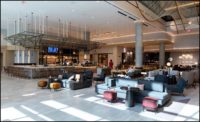Jess Koehler, hotel developer for TKO properties that manages the Candlewood Suites hotel in Grand Junction, CO, had been working in the hotel business for years and knew that efficient systems existed. He had worked on retrofits, but this was a new construction project, allowing him to start from scratch.
He installed packaged terminal air conditioners or PTACs, a common hotel application, which allows the guest to control the air temperature separately from the rest of the building. In an effort to operate efficiently, Koehler also employed an EMS that uses two motion sensors and a door sensor. When the system determines that a room is empty, it can adjust the temperature setpoint. Then when the guest returns, the system will revert back to the guest determined setting.
“This system provides the best of both worlds for the customer and for us since they get control and we get efficiency,” says Koehler. “I’m estimating that we’ll use 30% to 35% less energy than similar hotels with this system in place.
ICING ON THE CAKE
Koehler knew Xcel Energy offered rebates for the purchase of high-efficiency equipment, so he went online to see if his equipment was eligible.
“We realized we would recoup our incremental costs in energy savings over time, so we’d already made the decision to buy the equipment,” says Koehler. “But the rebate was the icing on the cake.”
This wasn’t Koehler’s first experience with rebate applications, but he was glad the process was simple. Everything he needed to know was available on the website.
For lighting, Koehler stayed on the efficiency path, choosing highly efficient compact fluorescent light bulbs (CFLs) throughout the hotel. CFLs use up to 75% less energy than incandescent bulbs and last up to ten times longer. A single bulb saves $50 in energy costs over its lifetime.
He says he’ll continue to look for other ways to save throughout the building. Guest comfort is still the top priority but when it’s done in a way that saves money, everybody wins.
The total cost of the project was $20,970, of which $7,650 was left after the Xcel rebate. With an estimated annual energy savings of $3,500 per year, the payback term is 2.5 years. ES





